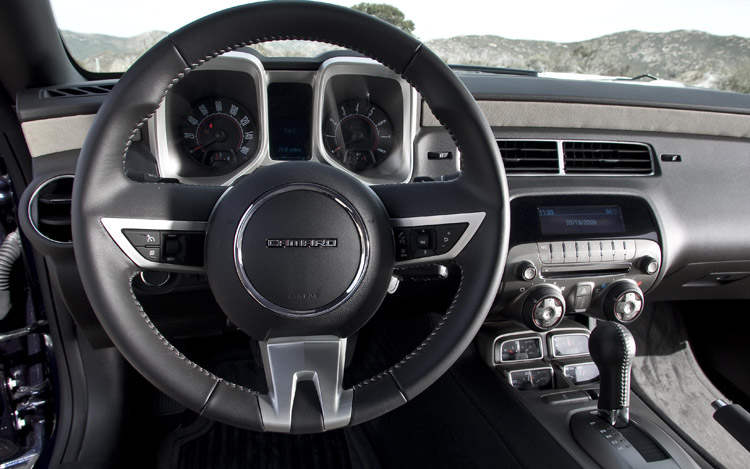 2010 Chevrolet Camaro
2010 Chevrolet CamaroChevrolet Camaro SS's 6.2L powertrains
Two 6.2L V-8 engines are offered in the Chevrolet Camaro SS, including the new L99 on automatic-equipped vehicles and the LS3 on manual-equipped models. Both engines are derived from the LS3 that debuted on the 2008 Chevrolet Corvette.
The 90-degree V-8 includes an aluminum block (with cast iron cylinder liners) and aluminum cylinder heads. The bottom end of the engine includes a new structural cast aluminum oil pan, with an oil capacity of 8.9 quarts (8.5 liters), while the two-valve cylinder head design is based on race-proven airflow dynamics. The intake valves measure 2.16 inches (55 mm) and exhaust valves are 1.60 inches (40.5 mm) in diameter.
The 6.2L engines also use a roller lifter-style camshaft with 5-percent greater intake-side valve lift than the Corvette's LS3. It manages airflow that is channeled through an acoustically tuned intake manifold with a composite design that reduces runner-to-runner variation. The throttle bore diameter is 90 mm.
Horsepower for the L99 is 400 (298 kW) at 5,900 rpm and torque is 410 lb.-ft. (556 Nm) at 4,300 rpm. The LS3 develops 426 horsepower (318 kW) at 5,900 rpm and 420 lb.-ft. (569 Nm) at 4,600 rpm (all numbers are SAE certified). Output on the L99 is lower than the LS3 because of a slighter lower compression ratio (10.4:1 vs. 10.7:1) and design features of the Active Fuel Management System. The L99 is paired exclusively with an automatic transmission.
As with the 3.6L models, the SS models employ a full dual exhaust system, with two catalytic converters to reduce back pressure.
Transmissions
All Chevrolet Camaro models can be equipped with either a six-speed manual or six-speed automatic transmission. The availability of a six-speed automatic transmission is a first for Chevrolet Camaro.
Standard with the 3.6L engine is the Aisin AY6 six-speed manual. It features lower shift effort and shorter throws for easier shifting and "fun-to-drive" characteristics. A hydraulic clutch and self-adjusting mechanism eliminates the need for adjustments throughout the lifespan of the transmission.
The Hydra-Matic 6L50 six-speed automatic is optional with 3.6L-equipped models. It has an aggressive 4.07:1 first gear ratio that delivers strong launches, but also provides tall overdrive ratios that decrease engine rpm and provide better fuel efficiency. The 6L50 also includes driver shift control, with the driver taking control via paddle shifts located on the steering wheel after selecting the "M" mode on the console-mounted shifter.
Performance Algorithm Shifting (PAS) is included with the 6L50. It lets the electronic transmission controller override the automatic gear selection during high lateral acceleration maneuvers.
On SS models, the new Tremec TR 6060 six-speed manual is paired with the LS3. It is designed to handle the high torque characteristics of the engine, while providing shorter throws, smoother gear synchronization and greater overall shift feel with little or no vibration. Its specs include a solid 290 mm flywheel and single-plate clutch. The final drive ratio for LS3 vehicles is 3.45:1.
Chassis control systems
All Chevrolet Camaro models include a four-channel StabiliTrak electronic stability control system that incorporates anti-lock braking, traction control and an active braking system to control wheel slip, optimize traction and enhance stability in wet, snow-covered or icy roads.
All SS models have a competitive/sport mode that optimizes the electronic stability control system for competitive driving and track conditions. It provides a less governed level of stability control for expert driving on race tracks. The stability control system engages only in severe oversteer or extreme acceleration in this mode.
New for Chevrolet Camaro SS models with a manual transmission is Performance Launch Control that is enabled in the competitive mode. It is designed to control wheel slip to an optimal level, allowing hard accelerations at launch to achieve maximum grip and vehicle acceleration.
Hydraulic brake assist also is standard on all models. The system activates during emergency braking by detecting the speed and force the driver applies to the brakes. Under certain conditions, the hydraulic brake assist may activate the ABS more quickly and easily than vehicles without the feature.
Wheels and tires
Standard on LS models are P245/55R18 all season BFGoodrich touring tires mounted on 18 x 7.5-inch steel wheels. Optional wheels include 18 x 7.5-inch and 19 x 8-inch aluminum alloy wheels. On the optional 19-inch wheel, P245/50R19 Pirelli Pzero Nero M+S may be ordered.
For SS models, 20-inch wheels are standard, with tire sizes of 245/45R20 up front and 275/40R20 at the rear. SS models are equipped with Pirelli Pzero summer-only, Z-rated tires. Twenty-one-inch wheels and tires are available as accessories through Chevrolet dealerships.
 2010 Chevrolet Camaro interior
2010 Chevrolet Camaro interior 2010 Chevrolet Camaro police car
2010 Chevrolet Camaro police car 2010 Chevrolet Camaro car
2010 Chevrolet Camaro car 2010 Chevrolet Camaro wallpaper
2010 Chevrolet Camaro wallpaper
No comments:
Post a Comment